
Catocala is a generally Holarctic genus of moths in the family Erebidae. The genus was erected by Franz von Paula Schrank in 1802. The moths are commonly known as underwing moths or simply underwings. These terms are sometimes used for a few related moths, but usually – especially when used in plural, not as part of a species name – they are used to refer to Catocala only.

Catocala meskei, or Meske's underwing, is a moth of the family Erebidae. The species was first described by Augustus Radcliffe Grote in 1873. It is found in North America from Maine and Quebec west to southern Alberta and Montana, south to South Carolina in the east and at least Montana in the west.

Catocala whitneyi, or Whitney's underwing, is a moth of the family Erebidae. The species was first described by G. M. Dodge in 1874. It is found in North America from North Dakota, Nebraska, and Kansas eastward through Wisconsin to Ohio and Tennessee. It has also been recorded as far west as Minnesota and Utah. In Canada, it has been found in Manitoba.
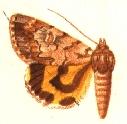
Catocala praeclara, the praeclara underwing, is a moth of the family Erebidae. The species was first described by Augustus Radcliffe Grote and Coleman Townsend Robinson in 1866. It is found in North America from Nova Scotia west to south-eastern Alberta, south to Florida and Kansas.
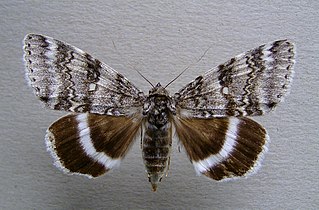
Catocala relicta, the white underwing or relict, is a moth of the family Erebidae. The species was first described by Francis Walker in 1858. It lives in southern Canada, from Newfoundland to Vancouver Island, south to Missouri, and Arizona.
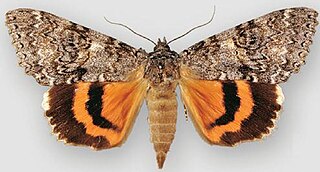
Catocala unijuga, the once-married underwing, is a moth of the family Erebidae. The species was first described by Francis Walker in 1858. It is found in North America from Newfoundland west to south central British Columbia, south to Kentucky and Missouri in the east, Colorado and Utah in the west.

Catocala obscura, the obscure underwing, is a moth of the family Erebidae. The species was first described by Ferdinand Heinrich Hermann Strecker in 1873. In Canada it is found in southern Quebec and Ontario and in the United States it is found from Massachusetts and Connecticut south to North Carolina, west to Mississippi and north to Iowa, Illinois, Ohio, and Michigan.

Catocala palaeogama, the old wife underwing, is a moth of the family Erebidae. The species was first described by Achille Guenée in 1852. It is found in North America from Ontario and Quebec, through Maine, New Jersey, Tennessee, to South Carolina, west to Arkansas and Oklahoma and north through Iowa, Indiana, Illinois and Michigan.
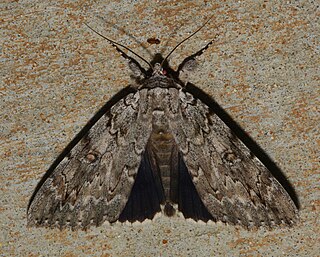
Catocala robinsonii, or Robinson's underwing, is a moth of the family Erebidae. The species was first described by Augustus Radcliffe Grote in 1872. It is found in North America from southern Ontario and New Hampshire south to Florida west to Oklahoma, Missouri and Arkansas and northward to Illinois, Indiana, and Michigan.

Catocala nebulosa, the clouded underwing, is a moth of the family Erebidae. The species was first described by William Henry Edwards in 1864. It is found in North America from southern Ontario south through Tennessee to Florida, west to Texas and eastern Oklahoma and north to Iowa, Michigan, Wisconsin and Minnesota.

Catocala subnata, the youthful underwing, is a moth of the family Erebidae. The species was first described by Augustus Radcliffe Grote in 1864. It is found in North America from Manitoba, Ontario, Quebec, and New Brunswick to Nova Scotia, south through Maine and Connecticut to North Carolina and west to Tennessee, Kentucky, and Texas, then north to Iowa, Wisconsin, and Michigan.
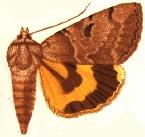
Catocala nuptialis, the married underwing, is a moth of the family Erebidae. The species was first described by Francis Walker in 1858. It is found in North America from Manitoba south through Minnesota and Nebraska to eastern Oklahoma and Texas and east to Kentucky and Illinois.

Catocala similis, the similar underwing, is a moth of the family Erebidae. The species was first described by William Henry Edwards in 1864. It is found in North America from Ontario and Quebec south through Maine and Connecticut to Florida, west to Texas and Oklahoma, and north to Minnesota.

Catocala texanae, the Texan underwing, is a moth of the family Erebidae. The species was first described by George Hazen French in 1902. It is found in the US state of Texas.

Catocala atocala, Brou's underwing or the atocala underwing, is a moth of the family Erebidae. It is found from Louisiana west to Oklahoma and north to southern Illinois.
Catocala charlottae or Catocala praeclara charlottae is a moth of the family Erebidae. It is found in Louisiana.

Catocala orba, the Orba underwing, is a moth of the family Erebidae. The species was first described by Nikolai Yakovlevich Kuznetsov in 1903. It is found from Massachusetts south to Georgia and Florida, west to Texas, and as far north as Mississippi.

Catocala sordida, the sordid underwing, is a moth of the family Erebidae. The species was first described by Augustus Radcliffe Grote in 1877. It is found in North America from Saskatchewan east to New Brunswick and Prince Edward Island and south through Maine and Connecticut to Florida, west to Texas and north to Manitoba.
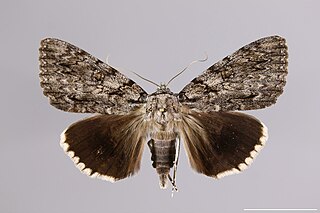
Catocala ulalume, the Ulalume underwing, is a moth of the family Erebidae. The species was first described by Herman Strecker in 1878. It is found in the United States from Virginia through Georgia to Florida, west to Texas and Oklahoma and north to Illinois.

Catocala dejeani is a moth of the family Erebidae first described by Rudolf Mell in 1936. It is found in China and Taiwan.














